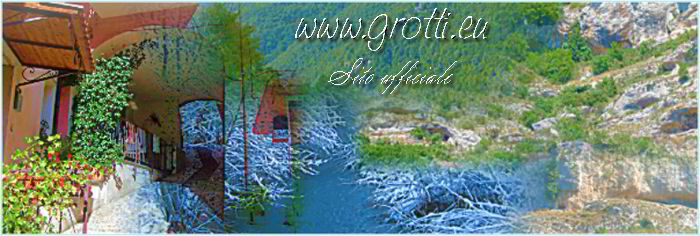|
History
The most considerable testimony
of our past is represented by the ruins that the inhabitants
call ‘Shattered Grotti’.
Unfortunately, Grotti’s
exact origins are unknown and until present, there are no
documents to indicate precisely when it was settled. The only
information available was taken from books about the Cicolano
area. There are traces pointing to a fortress in existence
since the 14th XIV° century. Before this period, however,
we only have a quotation from the ‘Compendio storico
del Marchesi’ (Historical compendium of the Marchesi)
indicating that Grotti was one of the villages christened
by the bishop of Amiterno St. Vittorino, who probably lived
during the kingdom of the Dominion of the Vespasiani family
of Rieti (about 96 B.C.) and sacrificed near Cotilia, a very
important Roman city.
The next trace from Grotti dates
back to the 14th century when its fortress was sacked during
the invasion of Ludwig de Bavarian in 1338, according to the
book ‘Compendio storico del marchesi’ (Historical
compendium of the Marchesi). Years later, when Louis of Hungary
invaded the Kingdom of Naples, Grotti was noted as being involved
in a dispute with neighbouring villages. Grotti then reappears
when Carlo VIII invaded Italy with his French troops. Marchesi
recounts that two hundred French soldiers stood at the Abbey
of St. Salvatore attempting to destroy Grotti’s fortress,
but they were stopped by Grotti’s inhabitants. Some
soldiers died falling from the high cliffs and many others
drowned in the river.
Grotti’s old fortress
is located above a recess in the rocks - stretching from the
east to the west with only one pathway connecting it. The
“Spinster’s Cave” is found in the central
part of the settlement. It is a hollow space inside of the
rock wall, located approximately five meters above the houses.
The name “Spinster’s Cave” indicates the
habit of locking up the young women to preserve their chastity.
One could access via ladders fixed to the cliff. Due to the
cave’s inaccessibility it must not have been difficult
to defend and in fact neatly arranged piles of stones were
most likely set aside in case of an attack. The eastern part
of the settlement was easily defended because the niche between
the two towers was difficult to reach. The upper tower, called
the prison, is square shaped and is located on the higher
point of the cliff. The lower tower is circular in shape and
connects the eastern town walls with the western one, protecting
the only path.
Most of the ruins were homes located on both sides of the
pathway, constructed on the steep slope, taking advantage
of protection from the caves that acted as a wall and also
roof. The largest house is underneath the Spinster’s
Cave. The ancient church of St. Victoria is found outside
of the city walls, below the settlement. It is a rather large
building, with a main square space upon entry and a smaller
room in the back reminding one of an apse. One knows that
the church and the remains of the houses on the path heading
east to the well, called “source erutti”, were
built after the settlement. Up to the beginning of the 1900s,
the church was the destination for burials.
The high plains of Ponzano were used as fields to provide
the village with grains. It is still possible to see the ruins
of St. Angelo’s church, the only proof of the ancient
settlement. A mysterious place in Ponzano is the “caves
of Constantine”, considered to be a Roman aqueduct in
the tourist guide “La Sabina nel tempo”, such
a hypothesis is based on the identification by the Emperor
Constantine who lived in the 4th century. The specialty of
these caves is the fact they are not completely accessible.
For many years the inhabitants of Grotti were dedicated to
the search of a hypothetical treasure sought by means of spiritual
séance. During one séance, the leader did not
wake immediately causing panic amongst the other participants.
The search for the treasure remains.....
Around the 18th century three villages grew from the settlement:
Grotti at the foot of the settlement, Casette approximately
four kilometers in the direction of Rieti and Ville Grotti
approximately one kilometer back towards the river Salto.
Probably the two newer villages allowed peasants to stay closer
to their land that was located too far from the old Grotti.
Looking at the map of Grotti, one can see that the Cittaducale
district, called “Gabelletta” or “Doganella”
was located on the other side of the river Salto near the
bridge. It is believed that this position gave Grotti a strategic
importance during the reign of Naples, being located on the
border of the Papal State and fortified by a practical road
that connected Rieti to the mountains of Cicolano. Elm trees,
hemp and vines were cultivated, with vines yielding abundant
grapes; but they were of rather poor quality, when compared
with those located further uphill near the old settlement,
where the soil was more rocky. They are still the products
of the earth today, but the general situation has completely
changed. In fact, thanks to the construction of the dam on
the Salto River during the 1930s, the fog, which used to pose
a problem, no longer invades the plains and the swamps have
been replaced with spacious fertile fields.
|

